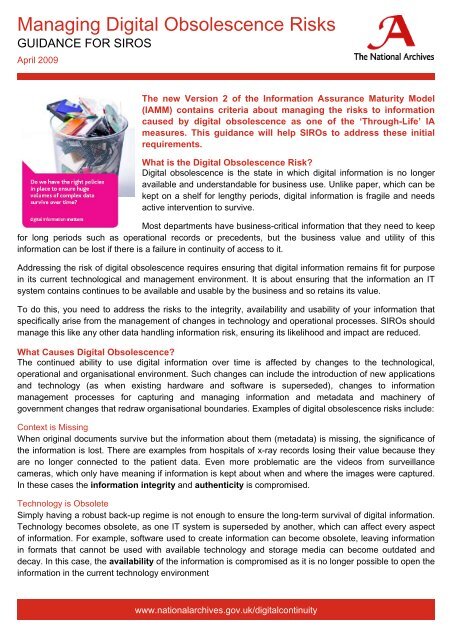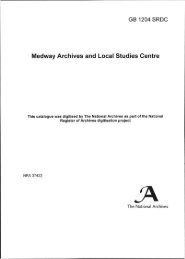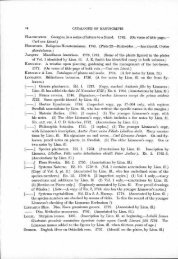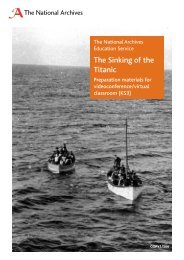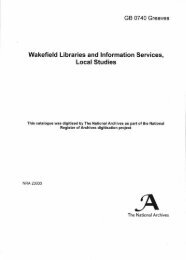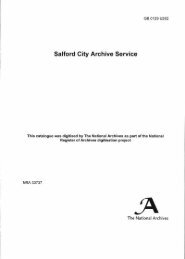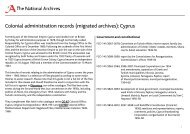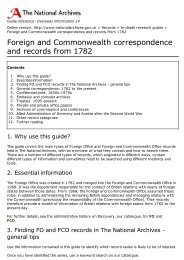What Is The Digital Obsolescence - The National Archives
What Is The Digital Obsolescence - The National Archives
What Is The Digital Obsolescence - The National Archives
You also want an ePaper? Increase the reach of your titles
YUMPU automatically turns print PDFs into web optimized ePapers that Google loves.
Managing <strong>Digital</strong> <strong>Obsolescence</strong> Risks<br />
GUIDANCE FOR SIROS<br />
April 2009<br />
<strong>The</strong> new Version 2 of the Information Assurance Maturity Model<br />
(IAMM) contains criteria about managing the risks to information<br />
caused by digital obsolescence as one of the ‘Through-Life’ IA<br />
measures. This guidance will help SIROs to address these initial<br />
requirements.<br />
<strong>What</strong> is the <strong>Digital</strong> <strong>Obsolescence</strong> Risk?<br />
<strong>Digital</strong> obsolescence is the state in which digital information is no longer<br />
available and understandable for business use. Unlike paper, which can be<br />
kept on a shelf for lengthy periods, digital information is fragile and needs<br />
active intervention to survive.<br />
Most departments have business-critical information that they need to keep<br />
for long periods such as operational records or precedents, but the business value and utility of this<br />
information can be lost if there is a failure in continuity of access to it.<br />
Addressing the risk of digital obsolescence requires ensuring that digital information remains fit for purpose<br />
in its current technological and management environment. It is about ensuring that the information an IT<br />
system contains continues to be available and usable by the business and so retains its value.<br />
To do this, you need to address the risks to the integrity, availability and usability of your information that<br />
specifically arise from the management of changes in technology and operational processes. SIROs should<br />
manage this like any other data handling information risk, ensuring its likelihood and impact are reduced.<br />
<strong>What</strong> Causes <strong>Digital</strong> <strong>Obsolescence</strong>?<br />
<strong>The</strong> continued ability to use digital information over time is affected by changes to the technological,<br />
operational and organisational environment. Such changes can include the introduction of new applications<br />
and technology (as when existing hardware and software is superseded), changes to information<br />
management processes for capturing and managing information and metadata and machinery of<br />
government changes that redraw organisational boundaries. Examples of digital obsolescence risks include:<br />
Context is Missing<br />
When original documents survive but the information about them (metadata) is missing, the significance of<br />
the information is lost. <strong>The</strong>re are examples from hospitals of x-ray records losing their value because they<br />
are no longer connected to the patient data. Even more problematic are the videos from surveillance<br />
cameras, which only have meaning if information is kept about when and where the images were captured.<br />
In these cases the information integrity and authenticity is compromised.<br />
Technology is Obsolete<br />
Simply having a robust back-up regime is not enough to ensure the long-term survival of digital information.<br />
Technology becomes obsolete, as one IT system is superseded by another, which can affect every aspect<br />
of information. For example, software used to create information can become obsolete, leaving information<br />
in formats that cannot be used with available technology and storage media can become outdated and<br />
decay. In this case, the availability of the information is compromised as it is no longer possible to open the<br />
information in the current technology environment<br />
www.nationalarchives.gov.uk/digitalcontinuity
Technology is Incompatible<br />
Older information may have been migrated to new formats to ensure its continued availability. However,<br />
new applications and operating systems used by the organisation may not provide the same functionality as<br />
previous systems. For example, dynamic formats transferred to PDF cannot be manipulated or interpreted<br />
as intended. In this case, the usability of the information has been compromised.<br />
How Does <strong>Digital</strong> <strong>Obsolescence</strong> Relate to Information Assurance?<br />
“Effective IA should ensure appropriate levels of availability, integrity, confidentiality, non-repudiation and<br />
authentication of information and information systems.” 1<br />
Availability of ongoing business information is a key aspect of Information Assurance (IA). IA has<br />
traditionally addressed the integrity and availability risks around data and IT systems. Addressing the risks<br />
of digital obsolescence can be understood as taking action to maintain the integrity, availability and usability<br />
of the information content for a business context. <strong>The</strong>refore the risk of digital obsolescence should be a key<br />
feature of any organisation’s IA strategy and information risk management practices.<br />
<strong>What</strong> Should You Do First?<br />
In order to meet the level one requirements of the Information Assurance Maturity Model, you simply need<br />
to ensure that there is a reference to the risk of digital obsolescence in your IA Risk Register, so that the risk<br />
forms part of the information risks being managed by your organisation. This reference might say:<br />
1. Risk:<br />
Integrity, availability and usability of digital information needed by the business will be lost due to digital<br />
obsolescence and changes in the technological, operational and organisational environment over time.<br />
2. Mitigating Action:<br />
• Identify material with long term business value<br />
• Identify the people in the organisation it impacts<br />
• Develop a plan for its long-term survival: identify staff that need to be involved and ensure this team<br />
contacts the <strong>Digital</strong> Continuity Project to plan its next steps. Relevant staff could include Information<br />
Managers, IT, Knowledge Managers, Records Managers or Information Assurance. (In many cases<br />
you will already have a team who are liaising with the <strong>Digital</strong> Continuity project)<br />
• Examine the list of first steps in this Guidance to help you determine what you can easily do next to<br />
begin to understand and manage your risks and move through the further levels of the IAMM<br />
<strong>What</strong> Should You Do Next?<br />
<strong>The</strong> <strong>National</strong> <strong>Archives</strong> is working with all major departments on the centrally funded <strong>Digital</strong> Continuity<br />
project to enable the long-term availability of government’s digital information. <strong>The</strong> project is developing a<br />
flexible shared service for central government that will include guidance, standards and a Framework of<br />
tools and services. Guidance will cover how to identify and manage information at risk of digital<br />
obsolescence, using a step by step approach. It will be published incrementally, as it is developed, at:<br />
www.nationalarchives.gov.uk/digitalcontinuity<br />
1 A <strong>National</strong> Information Assurance Strategy, Cabinet Office, p4.<br />
www.nationalarchives.gov.uk/digitalcontinuity
Appendix: First Steps towards <strong>Digital</strong><br />
Continuity<br />
To achieve level one of the Information Assurance Maturity Model, you must complete step one, outlined below:<br />
Step 1: <strong>Is</strong> <strong>Digital</strong> <strong>Obsolescence</strong> recognised as a potential risk in your organisation’s risk management structure?<br />
Make sure that loss of continuity to digital information is recorded as a potential risk in your risk<br />
management structure<br />
Ensure there is a risk owner for <strong>Digital</strong> <strong>Obsolescence</strong> who can escalate the risks to the Board’s attention<br />
if necessary<br />
Next steps<br />
<strong>The</strong> steps you need to take to address the risks of <strong>Digital</strong> <strong>Obsolescence</strong> are incremental. Here are some further<br />
actions your department can take to begin to understand and manage your risks and ensure continuity of your<br />
digital information. <strong>The</strong>se steps will help you progress through the levels of the Maturity Model.<br />
1. Do you know who is responsible for ensuring the continuity of your information?<br />
Appoint a Senior Responsible Owner who has overall responsibility of ensuring that there are systems<br />
and structures in place to ensure the continuity of information over time and through change<br />
2. Does your information asset register include details of information content as well as information systems?<br />
Undertake a technical audit so you understand the volume of data you hold, where it is, how old it is, and<br />
the range of formats it is held in. This could also allow you to understand better how quickly you are<br />
increasing the volume of data created and stored<br />
Use existing information management taxonomies to describe the classes of information that have<br />
ongoing value for the organisation or otherwise need to be kept. In particular, make sure you have a list<br />
of information classes that have to be kept for legal reasons, and know how long they have to be kept for<br />
Use the technical audit and information classes to create a comprehensive information assets register<br />
that maps your information landscape. If you do this, you will know what information you need to keep<br />
and what technology it is being kept in, as the first step towards understanding your digital obsolescence<br />
risks and mitigation requirements<br />
3. Do you understand how context adds value to your business information?<br />
Review metadata standards – are they adequate? Are they being followed?<br />
Review your comprehensive information asset register and identify what contextual information is<br />
needed for the content to be interpreted and used in the future<br />
4. Are you confident you can discover business critical information when you need it?<br />
Determine the amount of unstructured data you have and how it is managed<br />
Determine the level of risk to the organisation (e.g. financial, reputational) of having business-critical<br />
information in unstructured, hard to find places. This includes not being able to find information that<br />
might be the subject of legal discovery<br />
Determine how information flows through your organisation and what information is needed, when and<br />
by whom to support your business operations<br />
www.nationalarchives.gov.uk/digitalcontinuity
5. When you go through system change is the information you need still available and usable in the new<br />
system?<br />
Understand the technical profile of your information and what areas of your business critical information<br />
are at risk from digital obsolescence<br />
Make sure you know if you have business-critical information which was created by one system but not<br />
migrated during upgrades. Ensure you know how long the supplier intends to support those legacy<br />
systems<br />
Ensure adequate testing takes place on your business-critical information to check that you can continue<br />
to access and use it<br />
6. How are you ensuring your IT suppliers are supporting the ongoing integrity, availability and usability of your<br />
information?<br />
Talk to your suppliers to ensure they understand the issues and risks involved in maintaining digital<br />
continuity<br />
Test supplier assertions regarding the ongoing integrity, availability and usability of your digital<br />
information over time<br />
7. When you go through organisational change do you have contingency plans to ensure the survivability of<br />
information?<br />
Draw up a plan to ensure that each information asset owner is held accountable for the stewardship and<br />
safe hand over (if any) of information assets through Machinery of Government and other organisational<br />
changes. This should include an inventory of information described by technical and business value<br />
characteristics, based on the information asset register. It should also include a report to the relevant<br />
board(s) on how these assets were retained, redistributed or disposed of<br />
8. <strong>Is</strong> the management of your information risks balanced by business benefits?<br />
Ensure there is an understanding of the benefits that can be realised through having continuity of access<br />
to the right information and that business decisions about the need to keep and use information drive<br />
risk mitigation actions<br />
Ensure Information Management, Information Technology and Information Assurance are working<br />
together to support the business needs of the organisation and manage digital obsolescence risks<br />
collaboratively<br />
For more information<br />
Further guidance to help you achieve these steps will be available over the next 12 months.<br />
If you’d like to find out more about digital continuity visit www.nationalarchives.gov.uk/digitalcontinuity<br />
www.nationalarchives.gov.uk/digitalcontinuity


